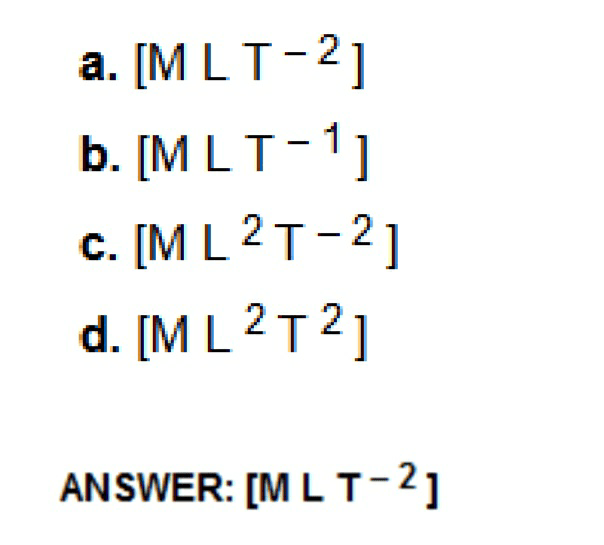Fluid Mechanics & Hydraulics (3140611)
MODULE 7: DIMENSIONAL ANALYSIS AND SIMILITUDE
1. Reynold’s number is the ratio of inertia force to
A. pressure force
B. elastic force
C. gravity force
D. viscous force
Answer: Option D
2. The ratio of the inertia force to the gravity force is called Froude number.
A. Agree
B. Disagree
Answer: Option A
3. Reynold’s number is the ratio of inertia force to
A. pressure force
B. elastic force
C. gravity force
D. viscous force
Answer: Option D
4. The ratio of the inertia force to the gravity force is called Froude number.
A. Agree
B. Disagree
Answer: Option A
5. Select the correct statement
A. Weber’s number is the ratio of inertia force to elastic force.
B. Weber’s number is the ratio of gravity force to surface tension force.
C. Weber’s number is the ratio of viscous force to pressure force.
D. Weber’s number is the ratio of inertia force to surface tension force.
Answer: Option D
6. The ratio of the inertia force to the surface tension force is called Weber’s number.
A. Correct
B. Incorrect
Answer: Option A
7. Euler’s number is the ratio of __________ force to pressure force.
A. inertia
B. gravity
C. viscous
Answer: Option A
8. Which is a full size structure employed in the actual engineering design?
a) Proton
b) Prototype
c) Electron
d) Neutron
Answer: b
9. Which term refers to the theory and art of predicting prototype conditions from model observations?
a) Nusselt number
b) Dimensional homogeneity
c) Thermal boundary layer
d) Similitude
Answer: d
10. Geometrically similarity prescribes that the ratio of the corresponding linear dimensions of the two systems are
a) Unity
b) Same
c) Never same
d) May be twice
Answer: b
11. The comparison of two systems made on the basis of their temperature, specific heat and heat flu is known as
a) Dynamic similarity
b) Kinematic similarity
c) Thermal similarity
d) Geometrical similarity
Answer: c
12. The similarity of masses and forces of the corresponding particles of flow is known as
a) Kinematic similarity
b) Dynamic similarity
c) Geometrical similarity
d) Thermal similarity
Answer: b
13. The similarity of motion is known as
a) Thermal similarity
b) Dynamic similarity
c) Geometrical similarity
d) Kinematic similarity
Answer: d
14. The similarity of shape and form is known as
a) Geometrical similarity
b) Thermal similarity
c) Geometrical similarity
d) Kinematic similarity
Answer: a.
15. Which of the following statements are true for dimensional analysis?
1. The functional relationship between dependent and non-dependent variables can be expressed into dimensionless terms by dimensional analysis
2. In model testing, it reduces the number of variables into three numbers
3. It is used to change the theoretical equation into dimensionless form
4. It helps to convert the units of quantities from one system to another system
a. (1), (2) and (3)
b. (2), (3) and (4)
c. (1), (3) and (4)
d. (1), (2), (3) and (4)
ANSWER: d. (1), (2), (3) and (4)
16. The unit of physical quantity which does not depend on the unit of any other physical quantity is called as
a. independent dimension
b. fundamental dimension
c. core dimension
d. none of the above
ANSWER: b. fundamental dimension
17. What are the dimensions of force?
18. Which of the following equations is not dimensionally homogeneous?
Consider standard symbols for quantities.
a. (Force) F = m x a
b. (Head Loss due to friction) hf = (f L V2) / (2 g d)
c. (Torque) T = F x Distance
d. None of the above
ANSWER: d. None of the above
19. Which of the following is a dimensionless equation?
a. Reynold’s equation
b. Euler’s equation
c. Weber’s equation
d. All of the above
ANSWER: d. All of the above
20. Which of the following number is applicable in open hydraulic structure such as spillways, where gravitational force is predominant?
a. Reynold’s Number
b. Euler’s Number
c. Weber’s Number
d. Froude’s Number
ANSWER: d. Froude’s Number
21. Reynold’s number is the ratio of the inertia force to the
A. surface tension force
B. viscous force
C. gravity force
D. elastic force
Answer: Option B
22. The product of mass and accelaration of flowing liquid is called
A. inertia force
B. viscous force
C. gravity force
D. pressure force
Answer: Option A

